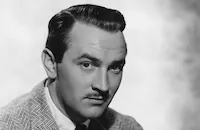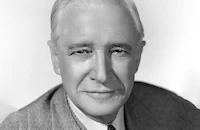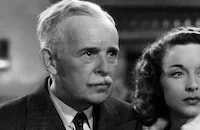Kid Glove Killer

Brief Synopsis
Cast & Crew
Fred Zinnemann
Van Heflin
Marsha Hunt
Lee Bowman
Samuel S. Hinds
Cliff Clark
Film Details
Technical Specs

Synopsis
With the help of Gerald I. Ladimer, a slick young attorney, Mayor Daniels and Turnley, the district attorney are elected on a reform ticket to smash the rackets that have been dominating their city. Unknown to the new mayor and district attorney, Jerry is in league with underworld boss Matty, who has promised to back him for the United States Senate in return for political favors. When Jerry realizes that the district attorney is serious about instituting reform, he notifies Matty and soon after, the district attorney is found murdered. After the mayor appoints him special prosecutor, Jerry visits the crime laboratory run by his old friend, chemist Gordon McKay and his assistant, Jane Mitchell. By meticulously piecing together the clues, Gordon determines that Turnley's killer is Allison Stacy. After Stacy is killed while resisting arrest, Eddie Wright, the owner of a small restaurant that has been victimized by the racketeers, determines to bring the criminals to justice and goes to the mayor's house to volunteer his help. There, Eddie is mistaken for a prowler and interrogated by the police. The mayor, meanwhile, summons Jerry to his office to question him about an expensive insurance policy he has just purchased. When the mayor demands to know the source of the money used to buy the policy, Jerry, fearful that an investigation would uncover his underworld connections, builds a bomb and plants it in the mayor's car. After the mayor is killed in the explosion, Eddie is arrested as a suspect. When threads from Eddie's coat match those found in the bombing, Jerry urges his arrest for murder, but Gordon remains skeptical. As the investigation progresses, Jerry falls in love with Jane and proposes to her, but she replies that she cannot quit her job until the murder is solved. Upon learning from Jane that Gordon has determined the bomber would have gun powder embedded under his nails, Jerry assiduously scrubs his hands to remove all traces of gun powder. One day, while examining some documents that he removed from the mayor's office, Gordon finds a remnant of a penciled notation regarding Jerry and deduces that Jerry must have murdered the mayor. To prove his suspicions, Gordon summons Jerry to his laboratory, then tricks him into a hair test that establishes his guilt. Later, Gordon informs Jane that he has solved the case by means of a hair sample, but refuses to divulge the killer's identity. Jane then meets Jerry at his house and after accepting his proposal, tells him that the case has been solved and that Gordon has traced the murderer through a hair sample. Realizing that Gordon has determined that he is the murderer, Jerry sets up an emergency meeting with Matty and hands Jane his car keys to drive herself home. Jane, who has been tracking down nail cutters as one of the clues, notices a cigar cutter attached to Jerry's key chain. Thinking that the cigar cutter may have been used to clip the bomb wires, Jane speeds to the lab to examine it. Jerry, meanwhile, meets with Matty, who hands him a pistol and instructs him to kill Gordon. As Jane inspects the cigar cutter in an interior room of the lab, Jerry bursts into Gordon's office, gun in hand, and demands the evidence. Hearing the commotion, Jane walks in just in time to hear Jerry admit that he killed the mayor. Gordon then jumps Jerry and overpowers him just as the police arrive. After Matty and his gang are arrested, Gordon realizes that he is in love with Jane, and when he proposes to her, she gladly accepts.

Director

Fred Zinnemann
Cast

Van Heflin

Marsha Hunt

Lee Bowman

Samuel S. Hinds
Cliff Clark

Eddie Quillan

John Litel
Catherine Lewis

Nella Walker

Ava Gardner
Ken Christy

Paul Fix
Leon Belasco

Connie Gilchrist

Naomi Childers
Jack Woody
Sam Ash
John Ince
Mitchell Lewis
Mary Currier
Al Hill
Jeff York
Ernie Alexander
Edward Hearn
Tom Murray
Eugene Borden

James Flavin

Emmett Vogan
Eddy Chandler

Howard Hickman

Edward Keane
George Carleton
Mark Daniels
Charles Wagenheim
George Lloyd

May Mcavoy
Florence Wright
Hugh Chapman
Bill Lally
Jack Sterling
Harry Strang
Ted Oliver
Crew
Jerome Bresler
Jack Chertok
Randall Duell
Cedric Gibbons
Hayes Goetz
John C. Higgins
John C. Higgins
Lee Jones
Allen Rivkin
Dore Schary
Douglas Shearer
David Snell
Paul Vogel
Edwin B. Willis
Ralph Winters

Videos
Movie Clip



Trailer
Film Details
Technical Specs

Articles
Kid Glove Killer
The film isn't a straight mystery but is what's known as a procedural, where the emphasis isn't on who did the crime but how the culprit is caught. From the opening viewers know the identity of the mayor's murderer but it's up to criminologist Heflin and his assistant Marsha Hunt to track down the guilty party. Standing in the way are a slick lawyer and corrupt government officials.
Fred Zinnemann had been working in the MGM shorts division, directing numerous entries in the Crime Does Not Pay series (he even won an Oscar for one, That Mothers Might Live, 1938). When the time came for him to make the jump to feature films, Zinnemann brought along the concise technique and sense of focus he learned making shorts. You can see that reflected not only in the tight 72-minute running time of Kid Glove Killer but also from the fact that it took only a mere three weeks to film it - without incident. The director later recalled that Ava Gardner -- who appears briefly as a car hop -- thought she did such a bad job she was ready to give up acting. (A very young Robert Blake is also glimpsed briefly in a car.) Zinnemann later claimed that during the film's preview, Louis Mayer and other studio executives learned about Carole Lombard's death and left during the screening. However, he may have been mistaken about this since Lombard's death was in January 1942, several months before the film's release and this was during a time when films were rarely held from release.
Screenwriter John C. Higgins had previously worked with Zinnemann on the Crime Does Not Pay series (in fact Kid Glove Killer is in some respects a remake of an earlier short called They're Always Caught). Higgins would later script some of Anthony Mann's early film noirs.
Marsha Hunt, the female lead in Kid Glove Killer, had an interesting career. She was a model who started working for Paramount and Fox in the mid-30s before signing with MGM in 1939. She appeared in numerous films including Pride and Prejudice (1940) and Blossoms in the Dust (1941) but was blacklisted during the 1950s and turned increasingly to TV appearances (including episodes of The Twilight Zone, Murder She Wrote and Star Trek: The Next Generation) and charity work. Oddly enough, a child support suit against Mick Jagger by somebody else named Marsha Hunt caused some news reports to confuse the two. Hunt later appeared on TV reciting a poem pointing out that she had never been involved with Jagger.
Producer: Jack Chertok
Director: Fred Zinnemann
Screenplay: John C. Higgins, Allen Rivkin
Art Direction: Cedric Gibbons, Randall Duell
Cinematography: Paul Vogel
Editing: Ralph E. Winters
Music: David Snell
Cast: Van Heflin (Gordon McKay), Marsha Hunt (Jane Mitchell), Lee Bowman (Gerald I. Ladimer), Samuel S. Hinds (Mayor Daniels), Cliff Clark (Capt. Lynch), Eddie Quillan (Eddie Wright).
BW-74m.
By Lang Thompson

Kid Glove Killer
Quotes
Trivia
Notes
The working titles of this film were Then There Were Two and Along Came...Murder. Although a December 1941 Hollywood Reporter news item lists Diane Dorsey in the cast, her appearance in the released film has not been confirmed. According to a December 1941 Hollywood Reporter news item, Lee Jones, who worked as technical advisor on the crime detection scenes in this film, was a member of the Los Angeles police departments chemical division. The Austrian-born Fred Zinnemann had worked in the U.S. as a director of documentaries and short subjects for many years. Although he had some co-directing feature credits prior to Kid Glove Killer, this was the first film on which he received sole directing credit. The film garnered favorable reviews with the New York Times noting that it was "a little crackerjack of a picture." Modern sources add Robert Blake to the cast as the boy in the cab.















